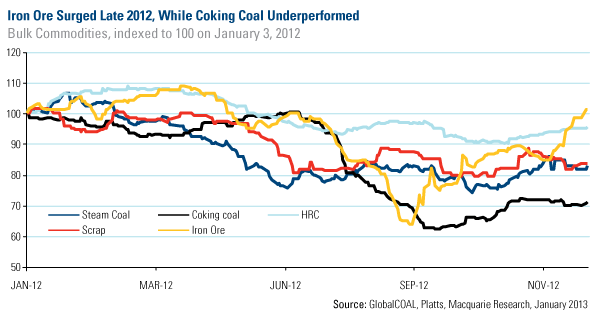Energy and Natural Resources Market Radar (January 7, 2013)

Strengths
- Spot prices for seaborne iron ore ended the year at a seven-month high in the wake of aggressive buying amid improved Chinese demand and steel pricing.
- Colombia reached its oil production goal of 1 million barrels per day as increased pumping in the southeast region boosted output despite sporadic attacks to infrastructure.
- According to China’s National Bureau of Statistics, total iron ore inventory at 30 major Chinese ports amounted to 73.14 million tons, down by 670,000 week-over-week, the ninth straight decline, and 22.46 million tons lower for the same period year-over-year.
- The Baltic Dry Index climbed 0.3 percent to 700, the first rise since November, lifted by gains for the largest vessels as miners sought charters to export iron ore & coal from Australia. The average charter rate for Capesizes rose 2.2 percent to $4,973 per day. Panamax Vessels fell 1.4 percent to $5,348 per day, its lowest level since early October.
Weaknesses
- Preliminary Chilean customs data show a fall in refined copper exports to China in November, suggesting current LME prices are discouraging local buyers, who will instead draw from domestic copper stocks.
- Natural gas prices have traded down from $4 per thousand cubic feet (Mcf) in late November to around $3.2 per Mcf currently as the hope of a cold winter has met the reality of another mild winter (8 percent warmer than normal so far).
Opportunities
- Met coal data points continue to be supportive of stronger 2013 pricing. Admittedly, in rear-view mirror but global steel output and iron ore prices (November data) both showing incremental strength while met coal prices have been relatively flat the last six weeks. More time is needed to work through remnants of oversupplied market but good demand data points help move the equilibrium point nearer.
- Hyundai Heavy Industries Co. & Samsung Heavy Industries Co., the world’s two largest shipbuilders, forecast a jump in orders this year, helped by rising demand for offshore drilling and production units. Hyundai Heavy is targeting annual orders for ships, offshore products and plant construction to surge 52 percent to $29.7 billion, according to a regulatory filing. Smaller rival Samsung Heavy aims to win orders worth $13 billion, 35 percent more than last year.
- Bloomberg Industry research stated that coal port expansions in the U.S. could add 42 million tons of capacity by 2017. Most of that increase comes from the Gulf where expansion at five terminals would add most of that capacity. This is on top of the potential increases on those port applications in the Northwest that need approval from the Army Corps of Engineers.
Threats
- Southern Copper’s workers at main operations in Peru could go on strike. Workers plan to hold contract talks soon with the company but could strike after January 15 if negotiations break down. Union members are pressing for a 15 percent wage increase as well as better safety conditions and health benefits while the company has offered no more than 5.5 percent.
- The current spike in iron ore prices is likely to be temporary, according to Rio Tinto’s management, and the company is set to stick to its plans to aggressively target cost reductions despite the improving market. Platts IODEX 62 percent Fe iron ore price jumped 20 percent month-over-month to $146.5 per ton on January 2.













